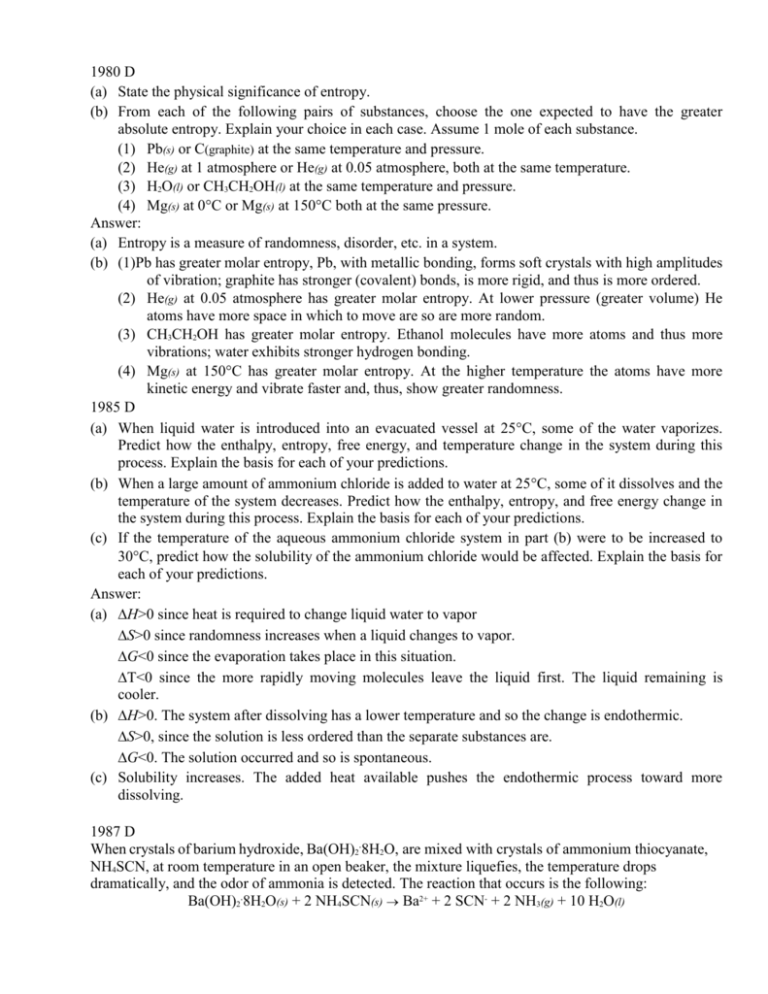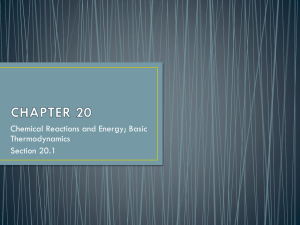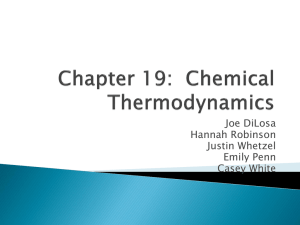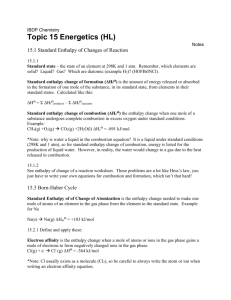1980 D (a) State the physical significance of entropy. (b) From each
advertisement

1980 D (a) State the physical significance of entropy. (b) From each of the following pairs of substances, choose the one expected to have the greater absolute entropy. Explain your choice in each case. Assume 1 mole of each substance. (1) Pb(s) or C(graphite) at the same temperature and pressure. (2) He(g) at 1 atmosphere or He(g) at 0.05 atmosphere, both at the same temperature. (3) H2O(l) or CH3CH2OH(l) at the same temperature and pressure. (4) Mg(s) at 0C or Mg(s) at 150C both at the same pressure. Answer: (a) Entropy is a measure of randomness, disorder, etc. in a system. (b) (1)Pb has greater molar entropy, Pb, with metallic bonding, forms soft crystals with high amplitudes of vibration; graphite has stronger (covalent) bonds, is more rigid, and thus is more ordered. (2) He(g) at 0.05 atmosphere has greater molar entropy. At lower pressure (greater volume) He atoms have more space in which to move are so are more random. (3) CH3CH2OH has greater molar entropy. Ethanol molecules have more atoms and thus more vibrations; water exhibits stronger hydrogen bonding. (4) Mg(s) at 150C has greater molar entropy. At the higher temperature the atoms have more kinetic energy and vibrate faster and, thus, show greater randomness. 1985 D (a) When liquid water is introduced into an evacuated vessel at 25C, some of the water vaporizes. Predict how the enthalpy, entropy, free energy, and temperature change in the system during this process. Explain the basis for each of your predictions. (b) When a large amount of ammonium chloride is added to water at 25C, some of it dissolves and the temperature of the system decreases. Predict how the enthalpy, entropy, and free energy change in the system during this process. Explain the basis for each of your predictions. (c) If the temperature of the aqueous ammonium chloride system in part (b) were to be increased to 30C, predict how the solubility of the ammonium chloride would be affected. Explain the basis for each of your predictions. Answer: (a) H>0 since heat is required to change liquid water to vapor S>0 since randomness increases when a liquid changes to vapor. G<0 since the evaporation takes place in this situation. T<0 since the more rapidly moving molecules leave the liquid first. The liquid remaining is cooler. (b) H>0. The system after dissolving has a lower temperature and so the change is endothermic. S>0, since the solution is less ordered than the separate substances are. G<0. The solution occurred and so is spontaneous. (c) Solubility increases. The added heat available pushes the endothermic process toward more dissolving. 1987 D When crystals of barium hydroxide, Ba(OH)2.8H2O, are mixed with crystals of ammonium thiocyanate, NH4SCN, at room temperature in an open beaker, the mixture liquefies, the temperature drops dramatically, and the odor of ammonia is detected. The reaction that occurs is the following: Ba(OH)2.8H2O(s) + 2 NH4SCN(s) Ba2+ + 2 SCN- + 2 NH3(g) + 10 H2O(l) (a) Indicate how the enthalpy, the entropy, and the free energy of this system change as the reaction occurs. Explain your predictions. (b) If the beaker in which the reaction is taking place is put on a block of wet wood, the water on the wood immediately freezes and the beaker adheres to the wood. Yet the water inside the beaker, formed as the reaction proceeds, does not freeze even though the temperature of the reaction mixture drops to -15C. Explain these observations. Answer (a) The enthalpy increases (H>0) since the reaction absorbs heat as in shown by the decrease in temperature. The entropy increases (S>0) since solid reactants are converted to gases and liquids, which have a much higher degree of disorder. The free energy decreases (G<0) as is shown by the fact that the reaction is spontaneous. (b) The water on the wood froze because the endothermic reaction lowered the temperature below the freezing point of water. The solution in the beaker did not freeze because the presence of ions and dissolved gases lowered the freezing point of the solution below -15C. The freezing point depression is given by the equation T = Kfm where m = the molality of the solution and Kf = the molal freezing point constant for water. 1988 D An experiment is to be performed to determine the standard molar enthalpy of neutralization of a strong acid by a strong base. Standard school laboratory equipment and a supply of standardized 1.00 molar HCl and standardized 1.00 molar NaOH are available. (a) What equipment would be needed? (b) What measurements should be taken? (c) Without performing calculations, describe how the resulting data should be used to obtain the standard molar enthalpy of neutralization. (d) When a class of students performed this experiment, the average of the results was -55.0 kilojoules per mole. The accepted value for the standard molar enthalpy of neutralization of a strong acid by a strong base is -57.7 kilojoules per mole. Propose two likely sources of experimental error that could account for the result obtained by the class. Answer: (a) Equipment needed includes a thermometer, and a container for the reaction, preferably a container that serves as a calorimeter, and volumetric glassware (graduated cylinder, pipet, etc.). (b) Measurements include the difference in temperatures between just before the start of the reaction and the completion of the reaction, and amounts (volume, moles) of the acid and the base. (c) Determination of head (evolved or absorbed): The sum of the volumes (or masses) of the two solutions, and change in temperature and the specific heat of water are multiplied together to determine the heat of solution for the sample used. q = (m)(cp)(T). Division of the calculated heat of neutralization by moles of water produced, or moles of H+, or moles of OH-, or moles of limiting reagent. (d) Experimental errors: heat loss to the calorimeter wall, to air, to the thermometer; incomplete transfer of acid or base from graduated cylinder; spattering of some of the acid or base so that incomplete mixing occurred, … Experimenter errors: dirty glassware, spilled solution, misread volume or temperature, … 1993 D 2 C4H10(g) + 13 O2(g) 8 CO2(g) + 10 H2O(l) The reaction represented above is spontaneous at 25C. Assume that all reactants and products are in their standard state. (a) Predict the sign of S for the reaction and justify your prediction. (b) What is the sign of G for the reaction? How would the sign and magnitude of G be affected by an increase in temperature to 50C? Explain your answer. (c) What must be the sign of H for the reaction at 25C? How does the total bond energy of the reactants compare to that of the products? (d) When the reactants are place together in a container, no change is observed even though the reaction is known to be spontaneous. Explain this observation. Answer: (a) S<0. The number of moles of gaseous products is less than the number of moles of gaseous reactants. OR A liquid is formed from gaseous reactants. (b) G<0. G becomes less negative as the temperature is increased since S < 0 and G = H -TS. The term “-TS” adds a positive number to H. (c) H<0. The bond energy of the reactants is less than the bond energy of the products. (d) The reaction has a high activation energy; OR is kinetically slow; OR a specific mention of the need for a catalyst or spark. 1995 B Propane, C3H8, is a hydrocarbon that is commonly used as fuel for cooking. (a) Write a balanced equation for the complete combustion of propane gas, which yields CO2(g) and H2O(l). (b) Calculate the volume of air at 30C and 1.00 atmosphere that is needed to burn completely 10.0 grams of propane. Assume that air is 21.0 percent O2 by volume. (c) The heat of combustion of propane is -2,220.1 kJ/mol. Calculate the heat of formation, Hf, of propane given that Hf of H2O(l) = -285.3 kJ/mol and Hf of CO2(g) = -393.5 kJ/mol. (d) Assuming that all of the heat evolved in burning 30.0 grams of propane is transferred to 8.00 kilograms of water (specific heat = 4.18 J/g.K), calculate the increase in temperature of water. Answer: (a) C3H8 + 5 O2 3 CO2 + 4 H2O (b) 10.0 g C3H8 1 mol C3H8/44.0 g 5 mol O2/1 mol C3H8) = 1.14 mol O2 VO 2 o (c) nR T P 1.14 mol 0 . 0821 L a t m m ol K 303 K 1 . 00 atm o o o = 28.3 L O2 ; f(28.3 L,21.0%) = 135 L of air o H comb H f (CO ) H f (H O ) H f (C H ) H f (O ) 2 2 3 8 2 -2220.1 = [3(-393.5) + 4(-285.3)] - [X+ 0] X = Hcomb) = -101.6 kJ/mol (d) q = 30.0 g C3H8 1 mol/44.0 g 2220.1 kJ/1 mol = 1514 kJ q = (m)(Cp)(T) 1514 kJ = (8.00 kg)(4.184 J/g.K)(T) T = 45.2 1997 D For the gaseous equilibrium represented below, it is observed that greater amounts of PCl3 and Cl2 are produced as the temperature is increased. PCl5(g) PCl3(g) + Cl2(g) (a) What is the sign of S for the reaction? Explain. (b) What change, if any, will occur in G for the reaction as the temperature is increased? Explain your reasoning in terms of thermodynamic principles. (c) If He gas is added to the original reaction mixture at constant volume and temperature, what will happen to the partial pressure of Cl2? Explain. (d) If the volume of the reaction mixture is decreased at constant temperature to half the original volume, what will happen to the number of moles of Cl2 in the reaction vessel? Explain. Answer: (a) The sign of S is (+). There is an increase in the number of gas molecules as well as a change from a pure gas to a mixture of gases. (b) G = H - TS. Both S and H are (+). As temperature increases, at some point the sign of G will change from (+) to (-), when the system will become spontaneous. (c) There will be no change in the partial pressure of the chlorine. Without a volume or temperature change, the pressure is independent of the other gases that are present. (d) The number of moles of Cl2 will decrease. The decrease in volume will result in an increase in pressure and, according to LeChatelier’s Principle, the equilibrium system will shift to the left (the side with fewer gas molecules) to reduce this increase in pressure. This will cause a decrease in the number of moles of products and an increase in the number of moles of reactant. 2003 D Answer the following questions that relate to the chemistry of nitrogen. (a) Two nitrogen atoms combine to form a nitrogen molecule, as represented by the following equation. 2 N(g) N2(g) Using the table of average bond energies below, determine the enthalpy change, ∆H, for the reaction. Bond Average Bond Energy (kJ mol– 1 ) N–N 160 N=N 420 NN 950 (b) The reaction between nitrogen and hydrogen to form ammonia is represented below. N2(g) + 3 H2(g) 2 NH3(g) ∆H˚ = –92.2 kJ Predict the sign of the standard entropy change, ∆S˚, for the reaction. Justify your answer. (c) The value of ∆G˚ for the reaction represented in part (b) is negative at low temperatures but positive at high temperatures. Explain. (d) When N2(g) and H2(g) are placed in a sealed container at a low temperature, no measurable amount of NH3(g) is produced. Explain. Answer: (a) a triple bond is formed, an exothermic process ∆H = –950 kJ mol–1 (b) (–); the mixture of gases (high entropy) is converted into a pure gas (low entropy) and the 4 molecules of gas is reduced to 2, a smaller number of possible microstates is available (c) ∆G˚ = ∆H˚ – T∆S˚; enthalpy favors spontaneity (∆H < 0), negative entropy change does not favor spontaneity. Entropy factor becomes more significant as temperature increases. At high temperatures the T∆S factor becomes larger in magnitude than ∆H and the reaction is no longer spontaneous (∆G > 0). (d) at low temperatures, the kinetic energy of the molecules is low and very few molecules have enough activation energy 2005 D [repeated in electrochem] AgNO3(s) Ag+(aq) + NO3–(aq) The dissolving of AgNO3(s) in pure water is represented by the equation above.. (a) Is ∆G for the dissolving of AgNO3(s) positive, negative, or zero? Justify your answer. (b) Is ∆S for the dissolving of AgNO3(s) positive, negative, or zero? Justify your answer. (c) The solubility of AgNO3(s) increases with increasing temperature. (i) What is the sign of ∆H for the dissolving process? Justify your answer. (ii) Is the answer you gave in part (a) consistent with your answers to parts (b) and (c) (i)? Explain. The compound NaI dissolves in pure water according to the equation NaI(s) Na+(aq) + I–(aq). Some of the information in the table of standard reduction potentials given below may be useful in answering the questions that follow. Half-reaction E˚ (V) O2(g) + 4 H+ + 4 e- 2 H2O(l) 1.23 I2(s) + 2 e- 2 I– 0.53 2 H2O(l) + 2 e- H2(g) + 2 OH– -0.83 Na+ + e- Na(s) (d) (i) (ii) (iii) (iv) -2.71 An electric current is applied to a 1.0 M NaI solution. Write the balanced oxidation half reaction for the reaction that takes place. Write the balanced reduction half-reaction for the reaction that takes place. Which reaction takes place at the anode, the oxidation reaction or the reduction reaction? All electrolysis reactions have the same sign for ∆G˚. Is the sign positive or negative? Justify your answer. Answer: (a) sign of ∆G = (–); since the dissolving of silver nitrate is spontaneous, then ∆G < 0 (b) sign of ∆S = (+); an increase in entropy occurs when a solid becomes aqueous and the products contain more particles than the reactants. (c) (i) sign of ∆H = (+); an endothermic process will be favored when the temperature is increased. (ii) yes; ∆G = ∆H – T∆S, as the temperature increases the –T∆S term will increase, keeping ∆G negative. (d) (i) 2 I– I2(s) + 2 e(ii) 2 H2O(l) + 2 e- H2(g) + 2 OH– (iii) anode = oxidation (iv) sign ∆G˚ = (+); by definition, an electrolysis is a non-spontaneous process and requires the input of energy to get it to proceed. 2006 B CO(g) + 12 O2(g) CO2(g) The combustion of carbon monoxide is represented by the equation above. (a) Determine the value of the standard enthalpy change, ∆H˚rxn for the combustion of CO(g) at 298 K using the following information. 1 C(s) + O2(g) CO(g) ∆H˚298 = –110.5 kJ mol-1 2 C(s) + O2(g) CO2(g) ∆H˚298 = –393.5 kJ mol-1 (b) Determine the value of the standard entropy change, ∆S˚rxn, for the combustion of CO(g) at 298 K using the information in the following table. S˚298 Substance -1 -1 (J mol K ) CO(g) 197.7 CO2(g) 213.7 O2(g) 205.1 (c) Determine the standard free energy change, ∆G˚rxn, for the reaction at 298 K. Include units with your answer. (d) Is the reaction spontaneous under standard conditions at 298 K? Justify your answer. Answer: (a) ∆H˚rxn = åDH f ( prod ) - åDH f (reactants) = (–393.5 kJ mol-1) – (–110.5 kJ mol-1 + 1/2(0)) = –283.0 kJ (b) ∆S˚rxn = åDS prod - åDSreactants = (213.7) – (197.7 + 1/2(205.1) J mol-1 K-1 = -86.6 J K-1 (c) ∆G˚ = ∆H˚ – T∆S˚ = (–283.0 kJ) – (298K)(-0.0866 KJ K-1) = –257.2 kJ (d) spontaneous; any reaction in which the ∆G˚ < 0 is spontaneous









